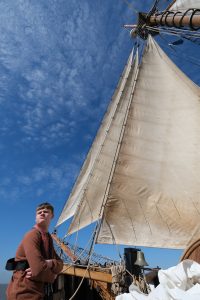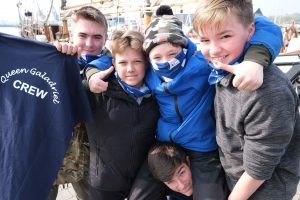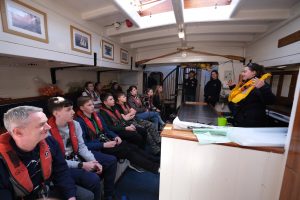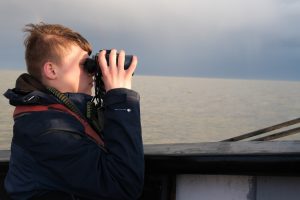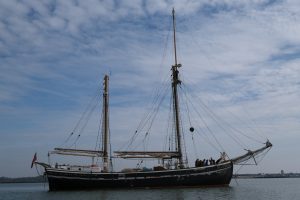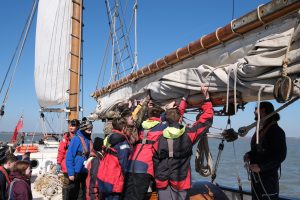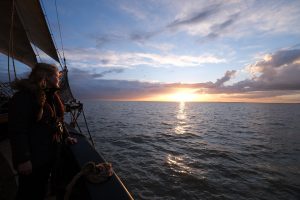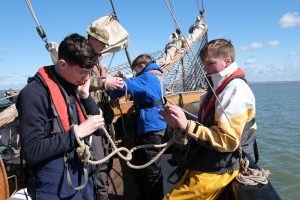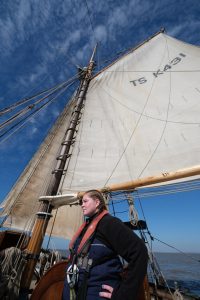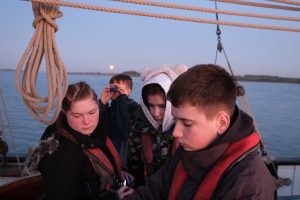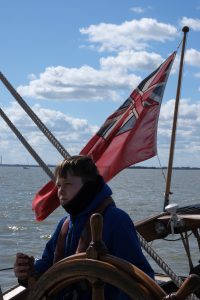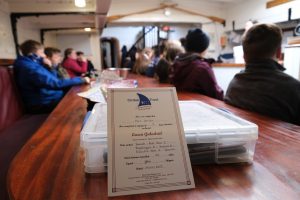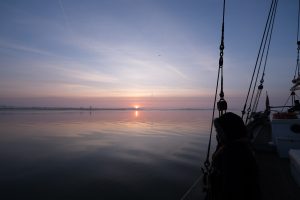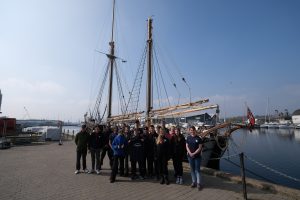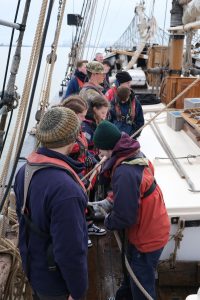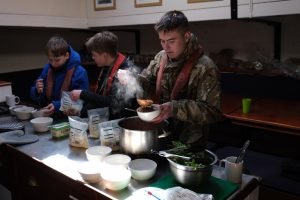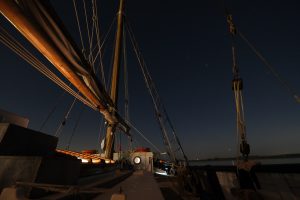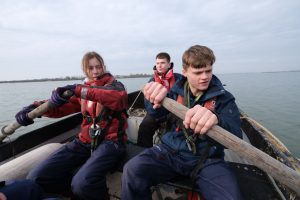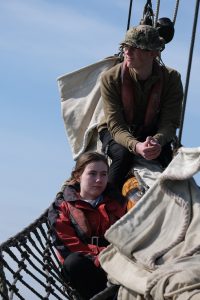Cirdan Sailing Adventure – 3 to 9 April 2023
1163 (Colne Valley) Squadron and 308 (Colchester) Squadron Air Training Corps
Report compiled by Corporal James Taplin
Day 1 – Monday 3 April
Not that we knew it yet, but as the cadets loaded the minibus and trailer at our HQ with 12 cadets and 2 staff from 1163 (Colne Valley) Squadron and the 2 cadets from 308 (Colchester) Squadron, we were about to embark on the most wonderful of adventures, filled with hard physical effort, long days and long nights and fuelled by the most fantastic self-prepared meals and a fabulous sense of camaraderie and teamwork.
We travelled to the Ipswich Marina where we became acquainted with the Queen Galadriel (QG), our sailing vessel for the week. Here the anticipation and excitement grew in wonder as to what was to come. The QG was built in 1937 at Svenborg in Denmark. Originally called Else after the first Captain’s daughter, she traded cargo along the coasts of Denmark and Norway and, in 1983, was bought by the Cirdan Trust, extensively restored, and entered service as the Queen Galadriel.
We met the professional crew, Skipper Charlotte, First Mate Louie, who was also mentoring Charlotte, as this was her first voyage as skipper, Bosun Oran and Mary, the fourth hand. The loading of the ship proceeded smoothly, including all the food that was in our planned menu for us and the crew. Would we really eat all of it? Next came the personal luggage to be stowed in the cosy bunk spaces! The crew then orientated us to the QG’s layout. This included how the heads (toilets) were pumped out and how the galley (kitchen) gas, water and cookers worked. We also received instruction on some emergency procedures and an in depth briefing on our life preservers, each of which was numbered, individually allocated, and then fitted. The life preserver became our constant companion and were the last thing we put on before going on deck, using buddy-buddy checks to ensure correct fitment. Then they either stayed on us or we hung them on a numbered hook by our bunks.
The crew were keen to get going and we quickly made our way out of the Prince Philip lock on to the River Orwell. It wasn’t long before we had to work together as a team, and, in so doing, get to know each other that little bit better. This was a smooth sailing down the River Orwell. Meanwhile we were divided amongst 3 watches, each watch being 3 hours in length throughout each 24-hour day. For example, green team (Viking watch) were on breakfast prep, then blue team (Sea gals watch) were on cleaning, whilst red team (RMC watch) were on deck, sailing or washing. Therefore, there was always a watch preparing or cleaning below decks, a team resting or cleaning and a team on deck sailing. However, for the larger sail hoists, everyone was required on deck. Apart from the ‘off’ watch, there was always something to do on QG, and everyone had an equal turn at each task.
For our first day, blue team were on dinner preparation and serving. To make life easier for us, this consisted of military 24-hour ration packs! Although we had a choice – chicken sausages, chickpea curry and rice or a chilli tuna pasta. Then for pudding it was either chocolate brownie in a chocolate sauce, sticky toffee pudding or mix fruits. These meals being heated in a pot of boiling water. Spoons at the ready, a plate was optional!
That night we anchored in the River Stour, opposite the Harwich ferry terminal. Through the night each team took turns on anchor watch, to ensure that the anchor held and that we did not drift. In fact, it is the length and weight of chain on the riverbed which holds the ship in place, and the anchor then holds the chain in place. Every 15 mins at least 2 people went on deck to take bearings on 3 different sets of lights, a buoy, a lighthouse and a crane in the port. These bearings were noted in a log, which is a legal document, and the bearings compared to reference bearings taken by the crew. If the bearing had changed by more than 10 degrees, we had to wake the crew as it would mean that the anchor and chain were moving, which could cause us to drift out of the anchorage and potentially into a shipping lane.
Day 2 – Tuesday 4 April
By 0600 we were all up and awake, although perhaps for some, not quite fully awake! Depending on one’s watch you either had 5-6 hours unbroken sleep or 2 periods of 3 hours. Breakfast was prepared for 0700 by the red team. This consisted of very welcome bacon sandwiches, plus bread, cereal and fruit. After we discussed the game plan for the day ahead, blue team went onto breakfast clear up duty and then into happy hour. Happy hour is not what you think! This hour of happiness was directed at making QG happy, by cleaning all the below deck areas. This consisted of sweeping the accommodation rooms, the galley and dining area, followed with a dustpan and brush. Then to ensure cleanliness and to make the floor shiny it was mopped. Others cleaned the galley area, the table and the heads.
At 0930 the anchor was raised, and we set sail out of the River Orwell into the open sea. Oh dear, the North Sea was not kind to us on this, our first meeting. By the time we got to the windfarm at Gunfleet Sands the sea had become really choppy. It didn’t take long before sea sickness claimed many, and several became very unwell. No pictures please.
The QG is less stable when powered by the engine. Therefore, at around 1130 there was sufficient wind, and so the crew got everyone on deck to rase the sails for the first time. We started this with the main sail. We were organised into two equal lines of people on each side of the ship.
What were we to pull? Is it a rope, a sheet or a halyard? There are only 7 ropes on a sailing vessel. You can look them up! For example, the bell rope. Otherwise, they are either a halyard, used to raise and lower a sail, or a sheet used to set or trim a sail. For ease, ropes will be used throughout. One team was tasked with pulling to raise the throat, this is the part which attaches to the mainmast, and the other on raising the peak (back edge of the sail) via the gaff, which is a wooden beam fitted across the top of the sail. Then it was on to the mizzen sail. Although smaller and set to the rear of the QG, this sail is raised in the same way as the main. With two equal lines formed, we pulled up the mizzen. Clear coordination between the teams is essential. This ensures that the sail’s weight is always biased towards the mast, and the sail is always under control. This ensures a safe and smooth hoist, without anything dropping or snagging.
When the wind was in our favour, we had the opportunity of raising the head sails. The head sails consist of the stay sail, inner jib and outer jib. To raise the stay sail two people were given the line that would pull the sail, meanwhile 5 people would untie the sail. The same would happen when raising the inner and outer jib, two of us raising or lowering with one member of the crew untying and guiding the sail. These sails are all attached to the bowsprite, the bit of wood, metal and netting which sticks out of the front of the QG, over the water.
By 1300 green team were on lunch prep, which was a delicious chorizo soup. Lunch provided time for all the teams to catch up with what they had been doing and have a laugh. Throughout the week every meal became a very social occasion. But also, like every meal we had that week, we had a briefing on what we were going to be doing or to let us know if anything had changed in the plan. After lunch green team were on cleaning duty. We then finished our beautiful day of sailing with anchoring up in the Blackwater estuary near Brightlingsea. By 1800, red team were on dinner prep. After dinner we planned what was going to happen the next day. We maintained our 3-Hr watch routine and took turns every 15 mins to monitor the bearings and ensure our mooring remained safe.
Day 3 – Wednesday 5 April
An 0600 start had become the routine to each day. It was a wonderful morning; the beautiful water was so still and looked super smooth. After breakfast the plan for the day was discussed. This was to be a day of activities at anchor. Following happy hour, both above and below decks, we played rock-paper-scissors to decide which teams would do what. The activities started with blue team getting a tour around the engine room and all of the machinery. At the same time green team rode in Gollum, the QG’s tender which is stored on the back of the ship, and red team had the opportunity of climbing the rigging.
The teams rotated through all 3 activities, which took us to lunch. After lunch we all discussed the plan for the evening, which was a run ashore. A few of us had an idea to make home or ship(!) made crabbing nets. The team order for the shore run was decided between the two groups.
Dinner that evening was vegetable chilli con carne. Once everyone and had finished their dinner we discussed the next day’s plan. Then for the entertainment, Pass the Squeeze. To win this game, the last person in each team has to grab at a banana with their eyes closed. The table was split into two equal teams, all with hands held on the table. Everyone with closed eyes. Except for the first person in each team who could see the cards. The Skipper turned normal playing cards over, when a red appeared a squeeze was passed along the team, the last person having to blindly reach and grab for the banana. If you grabbed the banana and a red card was showing, you won a move and the team rotated clockwise. If your team made an error, then you lost a turn your team rotated anticlockwise. The winning team was the first to get the starting person back to the beginning position around the table. The Skipper’s word was final!
Day 4 – Thursday 6 April
Very kindly the crew took anchor watch on Wednesday night into Thursday morning. This enabled us to have a full uninterrupted night’s sleep. The reason for this, was that Thursday started with everyone on deck by 0500. The route planning had been completed the night before. Our plan was to execute a 24-hour sailing voyage from anchorage to anchorage. When sailing in the dark, red lights are used to ensure everyone maintains their night vision. This ensures that everyone can get on deck quickly and safely if required.
Using the motor, we powered our way out of the Blackwater River and made our way into the North Sea. Again, we experienced choppy waters and thankfully we had all found our sea legs and sickness didn’t strike anyone. Soon after exiting the estuary with favourable winds and tides we were able to hoist the sails. The engine was silenced, and we enjoyed the pleasure of being under sail. Unfortunately, a few then became seasick!
In between breakfast and lunch everyone was called on deck for a team building exercise. The game was that you and a partner had been tied up to each other and had to become free without undoing the knots. We had 5 minutes to become free. Only the girls became free with the rest of the boys tied to each other. After having lunch, we had an update on what the weather was doing. Sadly, the weather had changed so a re-plan was required. At one point the wind was so slack that the tide was pushing us back towards where we had come from.
After the updated briefing we had a moment or two on deck, whilst the lunch team cleaned up below decks. We were then gathered back on top of the deck for a knot tying lesson. We started with a figure of eight then moved on to a reef knot. After a fun and very enjoyable lesson of knot tying, the dinner preparation team went below decks. We continued practicing the knots we had been taught. By early evening we sailed past the Principality of Sealand. Although not formerly recognised, it has its own flag, national anthem, coins, stamps and passports. It was built in international waters as a Maunsell Tower in WWII. Serving to protect the shipping lanes and provide anti-aircraft cover and has been subject of much controversy with various families and groups fighting over its occupancy and use.
Following dinner, we had a briefing on log keeping whilst under sail at night. Two people every hour would complete the logbook recording our location, speed, depth of water, wind speed and direction and each position was plotted on a chart with the time being noted.
Around 2330 hours the crew instructed the on-duty watch to wake everyone. With all hands on deck, we approached our anchorage, where we then dropped and stowed the sails. Stowing sails is very similar to the hoisting routine. However, it is extremely important that the lines are released slowly. We had to ensure that the sail and the gaff were always under control and didn’t drop to the deck. After 30 minutes we were anchored in the river Blackwater not far from where we had left that morning. We were then placed on overnight anchor watch.
Day 5 – Friday 7 April
Red team were last on watch and roused everyone at 0600 for breakfast preparation and consumption. Once everyone was full, we started the discussion on what we would do that day. The last 24 hours had been an amazing and thoroughly enjoyable sailing experience. Friday’s plan was to sail our way back to Ipswich and the River Orwell.
This morning was especially still and peaceful. Everyone heading onto deck fell silent and just watched and listened to the dawn. After breakfast with all hands on deck, we hoisted the sails.
Then before heading directly for Ipswich, we motored down to Radio Caroline (MV Ross Revenge), a pirate radio station which started broadcasting in 1964 in defiance of the BBC which had a monopoly over radio and wasn’t playing pop music. Many now-famous DJs started their careers with Radio Caroline.
After lunch we continued sailing, following the coast past Clacton-On-Sea. We then had a very funny and entertaining karaoke session and took to the deck and danced and sang to Southern Nights and American Pie, amongst other great tracks.
For dinner we had a most beautiful pie made by Viking watch. They had even decorated the crust! After the day’s review and the next day’s plan, we went on deck where we chilled and watched an amazing sunset.
We held anchor watch through the night. Green started, followed by blue and then red. When red team were on anchor watch they decided to do a bit of midnight crabbing using the gear and nets bought in Brightlingsea.
Day 6 – Saturday 8 April
Saturday morning felt like a slow start as everyone was tired from the previous day’s excitement, the range of activities, plus the night anchor watch. By 0630 all the boys were up and ready for breakfast, but it was a no show from the girls! Finally, after lots of knocking on the door, the girls were ready for an 0700 breakfast.
The afternoon’s weather was very grey and miserable, with little patches of rain. We were heading out into the North Sea for the final time. The plan was to practice person overboard drills. A float and a marker mast were used. As the float was thrown overboard, those on deck had to shout, “MAN OVERBOARD!”, and point at the object to ensure that its position remained marked. The crew went into action. Donning a harness and helmet, a member of the crew was dangled over the side of the vessel, using block and tackle. The skipper at the helm turned the ship around and lined up for a sail by. On the first pass a life preserver and ring were thrown to the overboard person. Then on the second pass the ship was manoeuvred to ensure that the dangling crew member could grab the person, for them both to be hoisted back on deck.
Following this excitement, we had time to relax on deck as we sailed back to Ipswich. We returned and entered the marina through the Prince Philip lock.
Once docked and the mooring lines tied fast, the anticipation grew as we were all going to have a shower for the first time in a week! Green team went first, followed by blue, not before offering some banter as to how much everyone else didn’t smell so good! Then once red team had prepared and served dinner, consisting of a butternut squash tray bake with chicken legs, it was their turn for the showers. This involved a little boat ride across the marina in Gollum, where red team were free to have the best shower of a lifetime. After everyone had showered, the crew gathered all of us around the table for the discussion of the deep clean of the ship. There was now an opportunity to purchase some merchandise, where nearly everyone went for a t-shirt. Once all the important stuff was sorted, we got to play a game. The game was a funny game as people had to put all their hands on the table, with arms overlapped. The game was to pass a slap on the table along in either a clockwise or anti-clockwise direction. If someone slapped the table twice the direction would change and if the person takes too long, hesitates or slaps with the wrong hand, they lose a hand on the table. If they lose their second hand, they are out of the game. The final 2 players then face each other in a decider, which was a ‘moo off’. Whilst facing each other on all fours on the floor, each takes a turn at ‘mooing’ in the other person’s face. The first person to laugh loses the game.
Day 7 – Sunday 9 April
After a very welcome lie in until 0700, we were all up for an 0800 breakfast. The end of the adventure was looming, and we all felt sad at the prospect of leaving the Queen Galadriel. After breakfast the deep clean started in preparation for disembarkation. From the bow to the stern, from the heads to the galley and from the cabins to the decks, we cleaned. The ship was looking better than when we boarded that long week ago! The minibus and trailer were collected, and we stowed all of our personal kit aboard – an easier task now, as we had no food to take back! The items we purchased were handed out and then we were presented with Royal Yacht Association Competent Crew qualification certificates. Once complete, plenty of group photos were taken on the dock side, including our new t-shirts.
The minibus journey back to Squadron HQ was quiet, as we were all exhausted. This enabled some reflection on what a truly wonderful adventure this had been. By the week’s end, the day of the week, or the time of the day didn’t matter. It all blurred, as what was important was what we were doing on each watch, ensuring that the ship was sailed, clean and tidy, and preparing the next meal. Mobile phones, wi-fi, social media all disappeared. Instead working with your team to sail, clean and cook had priority.
On the last night and early that morning, we each recorded a piece to camera. Something that we would Stop, Start and Continue doing. These captured lovely insights to each person’s experience and future thoughts. Our continuous discussions, planning and teamwork enabled us to experience an adventure that was only possible by coming together.
“This was one of the best groups of people I have taken out to sea with me in a long time”
Louie – Queen Galadriel Master Skipper
Cirdan Sailing Adventure – Exercise Achieve Together 2023
1163 (Colne Valley) and 308 (Colchester) Squadrons
—————————————————————————————
Reflecting back on the original aims of the expedition; the report above exemplifies how such a sailing trip is a fantastic mechanism for experiential learning within an adventurous and novel environment. Almost certainly everyone’s self-awareness, their acceptance of others, and a willingness to take controlled and managed risks, has developed. In so doing they will have discovered hidden strengths, talents, and gained an understanding of the value of working as a team. The daily briefings and reviews combined with the style and manner of instruction generated a continuous learning cycle during the voyage. The following were the specific aims of the expedition. It is assessed that each of these was achieved for each participant:
• Improving group morale and team bonding amid challenging environments.
• Inspiring an appreciation of individual strengths and weaknesses.
• Demonstrating the advantages of cooperation over competition.
• Enhancing communal support and communication.
• Improving decision making and individual leadership skills.
• Relieving stress levels through activities that inspire laughter and learning.
• Replacing limiting beliefs with possibility thinking.
• Inspiring ownership and accountability for all team members.
• Increasing Self-confidence and problem-solving skills.
• Promoting individual and group growth with fun through memorable experiences.
• Developing emotional intelligence.
• Increasing self-esteem, confidence and resilience.
By way of example. One of the participants was a late joiner to the Squadron. In the 18 months on our unit, whilst actively participating in parade nights; rarely are they heard, nor do they attend other activities. However, once seasickness was concurred, they took a lead in meal preparations and on deck duties. Then during one of the evening’s table games, which they won, became vocal, competitive and fully involved. The week was topped with them taking control of the entire crew to set the mizzen sails. Such has been the transformation, that an extension to their cadet career has been approved beyond their 18th birthday.
The 2 cadet force adult volunteers are ex-forces. Both remarked how this had been one of the very best adventurous training expeditions of their careers. It was remarked that although when originally invited, one adult could think of nothing worse than a week at sea and was desperately trying to find excuses not to attend. However, the week turned out to be incredibly memorable for the pleasure of sailing and in working in such a high performing team.
The Ulysses Trust also wish to thank the generosity of the Royal Air Force Charitable Trust for supporting this expedition. www.rafct.com

